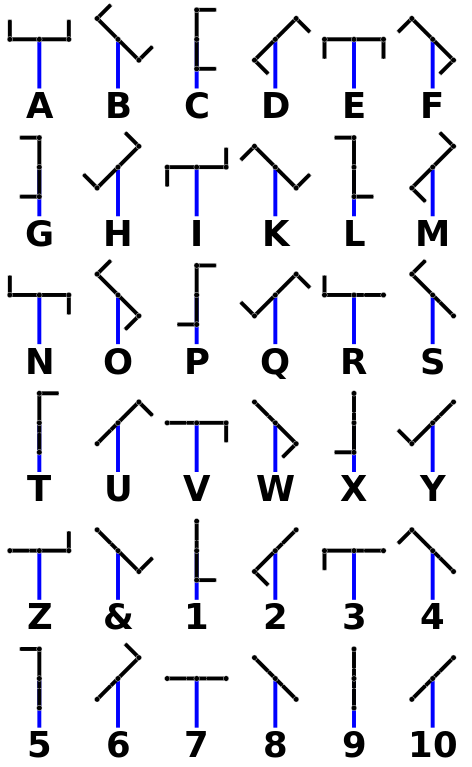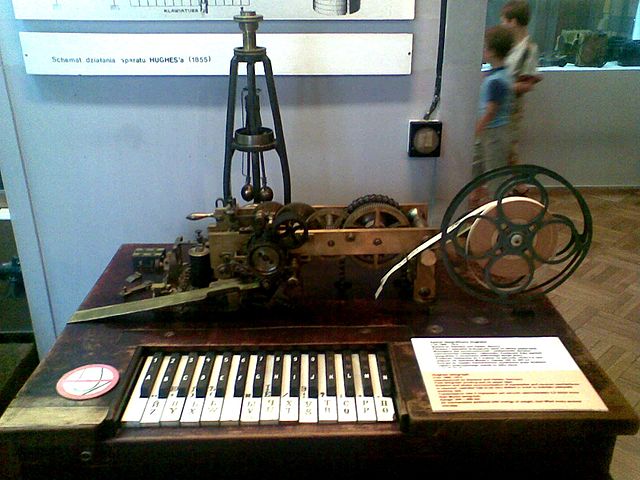| Vocademy |
The Electric Telegraph System
Before Electricity
Long before the advent of electronics, people used telegraph systems to communicate over long distances. These consisted of systems using smoke signals to torches and flags. One early system used by the ancient Romans had racks of flags or torches by night. This system is covered in Digital Electronics as it used codes similar to digital codes used with computers today.
Shortly before the invention of the electronic telegraph, other semaphore telegraph systems were used around Europe. One of the most famous was the Chappe system which used towers with signaling arms on top.

A Chappe optical telegraph tower.
The positions of the arms represented letters of the alphabet.

The code used with the Chappe system
Other systems used various flags, wands, and paddles, as shown below.

Murray Shutter Telegraph

Napoleonic Semaphore Telegraph
Electric Telegraphs
The invention of electric telegraphs followed shortly behind the advent of electricity. Ideas were postulated as early as 1753, where 26 wires would be connected to corresponding pith balls to represent each letter of the alphabet. Connecting static electricity to a wire would cause its pith ball to move. A system invented by Francis Ronalds in 1816 rotated a disk with letters of the alphabet engraved on it. The range of these early static electricity-powered systems reached as far as eight miles.
After the invention of the voltaic pile (the battery), relatively high sustained currents could power electric telegraphs. Around 1826, Joseph Henry used a voltaic pile and an electromagnet to send signals from his office at The Albany Academy to his nearby home. Exactly how this system worked is not recorded, but Henry publicly demonstrated a system that used the solenoid to ring a bell through a mile of wire.
Various systems were developed that used electromagnets to move needles to point at printed letters of the alphabet. In 1837, William Cooke and Charles Wheatstone built a system that used five needles, each controled by its individual wire. Two needles were activated at a time to point at a particular letter on a display with a matrix of letters.

The Cooke-Wheatstone system pointing at the letter 'G'
In 1840, Wheatstone developed the Wheatstone ABC Telegraph. This system had a dial engraved with letters of the alphabet, where each letter had a button next to it.

Wheatstone alphabetic telegraph
The operator pressed the appropriate button and turned a crank. This moved a needle past the letters of the alphabet, stopping at the button he had pressed. This turned a shaft with a magnet on it. With each shaft rotation, the magnet passed by a coil of wire, causing a pulse of electricity (this magnet and coil working together to generate electric pulses are called a magneto). The shaft made one turn as the needle passed each letter and a final turn as it stopped at the button. This sent the corresponding number of electric pulses down the wire to the receiver. The receiver had a solenoid that moved a needle around a dial, passing each letter of the alphabet as each corresponding pulse arrived. For example, if the operator pressed the button for the letter 'C,' the system sent three pulses as the needle moved around the dial to the letter 'C.' The receiver moved its needle to the letter 'C' on its dial.
The Morse Telegraph
Samuel Morse and his assistant, Alfred Vail, developed a recording telegraph in 1837. This used a solenoid-mounted pen to mark long and short marks on a moving strip of paper. Morse and Veil developed the famous Morse code for this system. The transmitter was a clumsy system where the operator drew a length of wood across a switch. The wood had notches that would close and open the switch. The entire system was quickly abandoned as it was easier for the operator to memorize the Morse code and send it using a specially designed switch called a key. The recording receiver was replaced with a simple solenoid clacker (sounder). The receiving operator also memorized the code and wrote the letters on paper as he received them.

The Morse Key and Sounder system
Morse first demonstrated his system over two miles of wire near Morristown, New Jersey, on 11 January 1838. In late 1843 or early 1844, Morse began constructing the first telegraph line in the United States. It would stretch from Baltimore, Maryland, to Washington, DC. As of 1 May 1844, the line was completed from Baltimore to Annapolis Junction. News that Henry Clay had been nominated for President by the Whig party in Baltimore was sent to Annapolis Junction over this line. As of 24 May 1844, the line was completed and tested, and Morse made the first public demonstration sending the message "WHAT HATH GOD WROUGHT" from Washington to Baltimore. The Morse system required skilled operators, but they could send messages much faster than earlier alphabetic systems. In 1851 it was adopted in mainland Europe. The Morse system remained popular even after printing telegraphs were quickly developed. This is likely because the system was inexpensive and easy to set up and maintain, being only a battery and a couple of switches and solenoids.
Printing Telegraphs
In 1846, Royal Earl House (that's a name, by the way) patented a printing telegraph using a system with synchronized rotating wheels. Descriptions are vague, but the system worked by sending regular pulses from the transmitter to the receiver to keep rotating wheels synchronized (judging by the transmission speed, I assume that the wheels rotated two times per second). The receiving wheel had typeface letters that were inked and pressed against paper tape. The operator pressed a switch/key on a piano-like keyboard to transmit a letter. This connected with the transmitter's wheel so that it closed and opened a switch just as the receiver's wheel rotated the proper typeface letter in position to print on a paper tape. House's printing telegraph could convey up to 2000 words per hour. In 1855, David Hughes improved House's printing telegraph. Around 1856, the Hughes printing telegraph was adopted by Western Union.

The Hughes Printing Telegraph
In 1874, Émile Baudot (pronounced Baw-dough) developed a system that used a six-bit code (called five units at the time). In his system, time was reserved for a series of six pulses. Pulses could either be present or absent in their allotted time. The pattern of present and absent pulses constituted what letter of the alphabet was being sent. This code was later refined to use only five bits. The transmitter operator had five keys, two for the left hand and three for the right hand.

A Baudot Transmitter
He memorized the Baudot code and pressed keys in the right combination to send a particular letter. At a regular cadence, the keys were locked in their current position while a mechanism read the keys and sent the corresponding set of pulses. When the keys were released, the operator could send the following letter. The operator had to work at the cadence of the machine. The system worked too fast for any operator to keep up. Up to six transmitters could be linked together, and six operators could send six separate messages simultaneously (actually in quick succession). When it was time for the system to transmit, it would lock all six keyboards and read and transmit their information sequentially.
The receiver stored the signal in five solenoids. Once stored, the information was used to push a strip of paper against the inked type wheel just as the correct letter rotated into position. I have not been able to find out how the decoding mechanism worked, but here is a video that shows a restored Baudot printing telegraph in action:
Emile Baudot Printing Telegraph (teletype)
Baudot's receiver operated unattended but still required operators for the transmitter.
In 1901, Donald Murray developed a system that used a typewriter-style keyboard. Murray's system also had to capability to punch holes in paper tape rather than send the message directly to the receiver. This relieved the system of working at the speed that operators could maintain. Multiple operators could punch tape at one time, then the tape could be loaded into the transmitter, and the message sent at high speed. Messages could be sent as fast as the tape could be read (one transmitter being loaded with tape while another was transmitting).
In 1916, Edward Kleinschmidt patented a design for a printing telegraph that printed on a roll of paper, the print mechanism moving across the sheet like a typewriter. The first working page-printing teleprinters were developed in 1924.
After some mergers, Kleinschmidt's company morphed into the Teletype Corporation, and printing telegraphs became known as Teletypes.
Teletype ASR 33 Part 10: ASR 33 Demo
These mechanical monsters were widely used when the first computers were developed, so using Teletypes to communicate with early computers was natural. Today's computer keyboards have their roots in the Teletype, particularly with the Esc and Ctrl keys that are holdovers from the Teletype.[1]
ASCII Code
Over the years, the five-bit Baudot code evolved into a seven-bit code standardized into the American Standard Code for Information Interchange (ASCII) in 1963. ASCII became the standard code for storing and conveying alphanumeric text messages (i.e., pain text) in teleprinters and computers. All modern computers have extended the ASCII code to eight bits. However, there is no standard for interpreting the eighth bit. To this day, when you press a key on an English computer keyboard, the ASCII code for the associated letter is stored somewhere in the computer's memory.
|
There is an interesting legacy of the computer's connection to teleprinters. On ASCII-based teleprinters, holding the Ctrl key and pressing the G key sends the code 0000111 to the receiving teleprinter. This tells the receiving teleprinter to ring the bell. From the original IBM PC through Windows 11, if you send the binary code 00000111 to the console (the command line interpreter), the computer will beep or make the default Windows notification sound. Try it:
This will copy the xcopy program to the console. The xcopy program has several bytes with the binary number 00000111 (7 in decimal). If xcopy.exe were a text file (ending in .txt), the console would simply print the text to the screen. However, since it is a program file, it will look like gibberish.[2] owever, each time the console receives the number 00000111, the computer will beep. Your computer may beep repeatedly or make the default notification sound once. This will work with almost any system file (.exe, .dll, etc.). A modern computer no longer sends the number 00000111 to the console when you press Ctrl-G. |
| Vocademy |